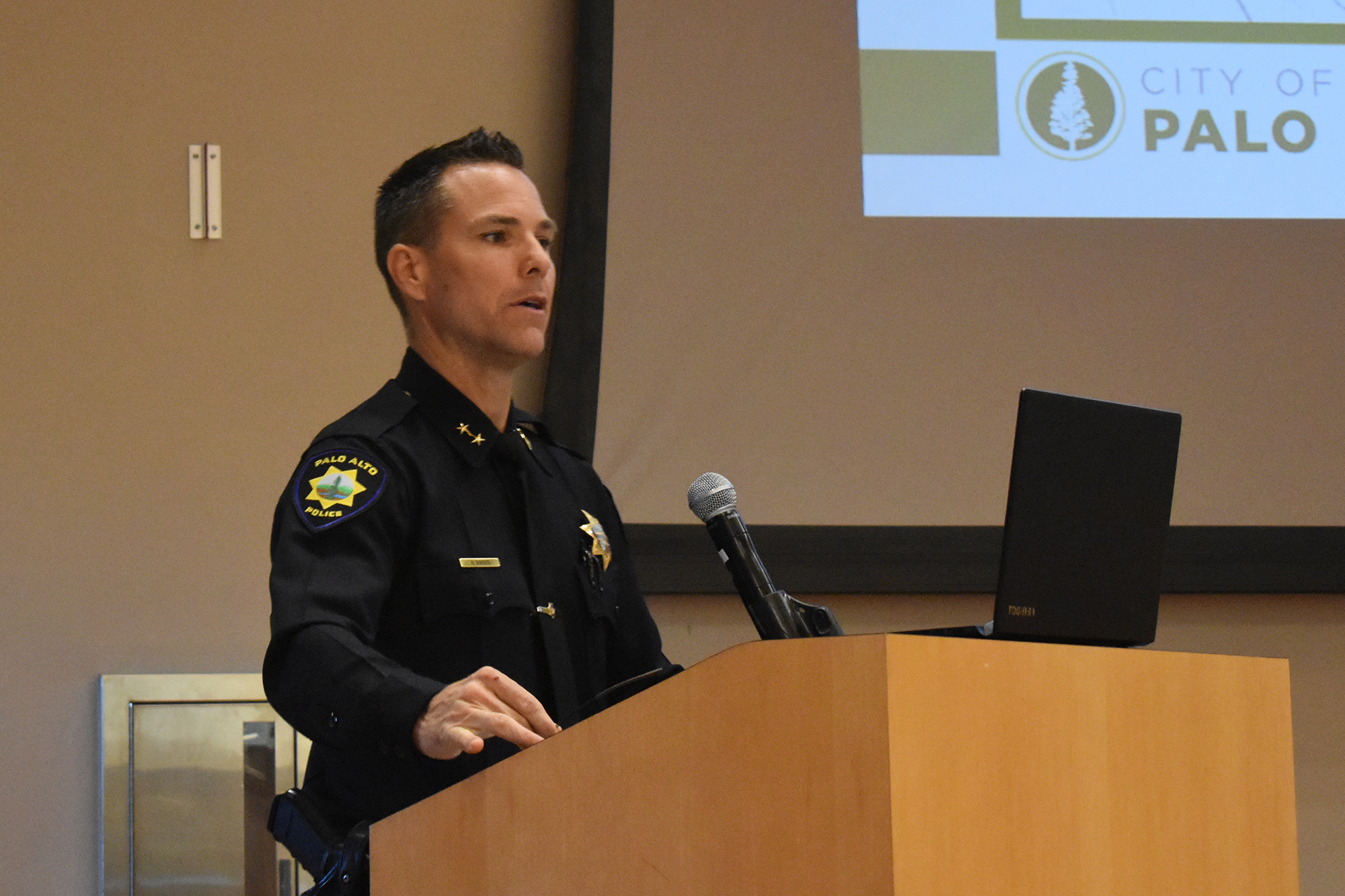This article is the second in a three-part series detailing the Palo Alto Police Department's actions to investigate a violent 2018 arrest by its officers, penalize those involved and then defend its actions when its decision was appealed. Read part 1.
PART 2: THE REVIEW
It took the Palo Alto Police Department more than a year for its internal investigation into a violent 2018 arrest by one of its officers at the Buena Vista Mobile Home Park to really take off.
In April 2019, the city received a claim from Gustavo Alvarez, the man who'd been arrested, along with video from his Ring security camera showing what happened on the evening Feb. 17, 2018. When the department learned about the video and the lawsuit, it assigned the review to Lt. April Wagner and Lt. Ben Becchetti. Before long, it was handed over to then-Acting Captain James Reifschneider.
By that time, news of the violent arrest was spreading fast. Local television stations and news sites, including Palo Alto Online, posted the surveillance footage released by Alvarez's attorney Cody Salfen. It showed officers arriving at the scene, calling for Alvarez to leave the house, kicking his door down, pulling him out and handcuffing him.
Sgt. Wayne Benitez can then be seen slamming Alvarez on the hood and windshield of his car and saying, "You think you're a tough guy? Huh?"
"I'm bleeding," Alvarez responds.
"You're going to be bleeding a whole lot more," Benitez tells him.
While the department's policy requires officers to intervene when they see unlawful use of force, this did not occur. Agent Thomas DeStefano claimed in an interview with then-Acting Captain James Reifschneider that he was talking on his radio and did not see or hear Benitez slam Alvarez against the car, according to a memo from the internal-affairs investigation.
Reifschneider wrote that DeStefano told him that he "did not see what precipitated this but assumed Alvarez had begun resisting again."
DeStefano also claimed that at no time did he hear Alvarez state that he had been hit or that he was injured. Once DeStefano saw that Alvarez was handcuffed, he became "temporarily preoccupied with radio traffic," according to the memo.
DeStefano recalled to Reifschneider his prior run-ins with Alvarez, including an episode in fall 2017 in which he tried to arrest Alvarez at his home (the reasons for the arrest were redacted in the interview transcript). He said Alvarez opened the door and was holding a hot iron in his hand. DeStefano grabbed Alvarez, who then put the hot iron down, and DeStefano handcuffed him and took him to jail.
DeStefano told Reifschneider that when he arrived at Buena Vista on Feb. 17, 2018, he believed that Alvarez had a suspended driver's license and that he was on searchable probation. When other officers arrived, they came up with a plan to go to the front door and try to persuade Alvarez to come out. When he didn't come out, Benitez proposed kicking the door and then proceeded to do so twice, breaking it, according to the interview.
Though all charges against Alvarez were ultimately dismissed, DeStefano said that he and other officers believed that the urgency of getting to him justified a forced entry.
"I would say yes, absolutely, there was an urgency to, to get him from either accessing a weapon or destroying or concealing contraband." DeStefano said during the interview.
DeStefano maintained that he did not see Benitez land any "blows" on Alvarez or commit any other type of violent conduct. When Reifschneider showed him the surveillance footage of Benitez slamming Alvarez on the hood of the car and asked him to describe what he saw, DeStefano said it looked like Benitez "kinda tapped him on the head." He also said it did not look like Alvarez's face had actually hit the windshield.
"It's hard to tell on the, maybe he's pushing him or if he's, if he's throwing a jab in there, and then also looks like he picks him up and puts him back over the patrol car," DeStefano said in the interview.
He called the arrest a "dynamic situation" and said he wasn't able to see during that time whether Alvarez was resisting arrest by, for instance, stomping on Benitez's foot.
His argument that he didn't see exactly what happened appeared to at least partially sway Reifschneider, who laid out his findings in a 34-page report on May 5, 2021. He concluded that DeStefano had violated three department policies relating to use of force, pointing a firearm and failure to adequately review a police report.
But Reifschneider also wrote that he could not sustain the allegation that DeStefano violated department policies that require officers to intercede and report an unlawful use of force. It's possible, Reifschneider wrote, that DeStefano did not see the hood slam.
"While I cannot eliminate the possibility that Agent DeStefano saw the use of force and recognized it as unreasonable, it is also entirely plausible that he did not based on the facts presented," Reifschneider wrote.
"Lastly, even if Agent DeStefano had seen the force and recognized it as unreasonable, he was likely not 'in a position' to intercede as the entire use of force occurred within mere seconds. Therefore, the facts do not support a finding that he failed to intercede or failed to report unreasonable force."
Two weeks later, however, then-Assistant Chief Andrew Binder completed his own memo that took a harder line on DeStefano's conduct. In a departure from Reifschneider's recommendation, Binder concluded, based on video footage, that DeStefano was near Benitez when the hood slam occurred and that his "head remained positioned with the direct line of sight" of what occurred between Benitez and Alvarez. The evidence, Binder argued, suggests that DeStefano actually saw what happened.
"Agent DeStefano's head and body remained aligned and positioned towards Sergeant Benitez and Mr. Alvarez and Mr. Alvarez was slammed into the windshield/hood area by Sergeant Benitez," Binder wrote.
DeStefano's actions after the hood slam -- namely, omitting the episode from police reports while also sending a message about it to another colleague and pantomiming the action by slamming his hand on the hood of a car -- also suggested to Binder that DeStefano wasn't ignorant of what happened but rather "minimized his role in what occurred in the carport area."
"Had the surveillance video not come to the Department's attention, Agent DeStefano's actions at the scene would have most likely never been brought to light. This lack of documentation is critical because Agent DeStefano, acting in a supervisory capacity, later reviewed and approved Sergeant Benitez's report, which was false and misleading," Binder wrote in his May 16 memo, which was forwarded to Jonsen.
"Agent DeStefano had motive to not document his own actions and observations and then later sign-off a report he knew was false; such conduct concealed his own culpability for misconduct in this incident."
Binder also underscored in his memo how DeStefano's conduct was "unbecoming a member of this department and reflected unfavorably upon the Palo Alto Police Department and its members."
"It also provided insight into what he thought about this incident; that what happened to Mr. Alvarez was amusing and provided an entertainment opportunity to be shared with others," Binder wrote.
For Binder, the path forward was clear: DeStefano should be fired. A month after issuing his recommendation to Jonsen, Binder informed DeStefano that he was recommending termination.
"Your conduct was despicable and has had an extremely negative impact on the public's trust in this Department," he wrote to DeStefano on June 24, 2021. "You covered up an unjustified use of force that eventually came to light only because of Mr. Alvarez's home surveillance system and his pursuit of legal claims against the City."




Comments